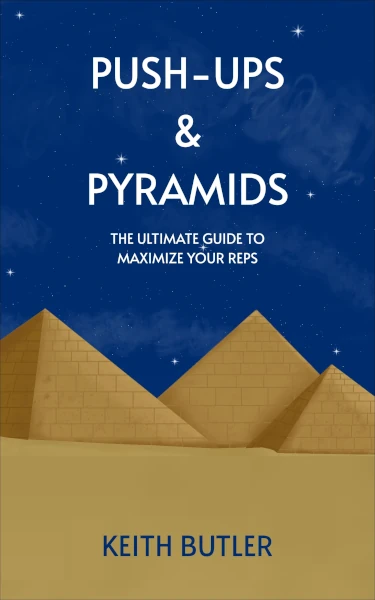
Introduction
There are many strategies in the fitness world to improve strength, build muscle, and enhance endurance. Among these methods, one that stands out for its simplicity and effectiveness is Reverse Pyramid Training, or known by it’s acronym – RPT. This approach is particularly valuable for bodyweight exercises like the push-up, turning a simple move into a powerful strength-building workout.
What is Reverse Pyramid Training (RPT)?
Reverse Pyramid Training upends traditional pyramid training by starting with the most challenging set and progressively moving towards easier ones. Instead of building up to the peak difficulty, you begin there, and as your energy diminishes, the exercise becomes easier.
The key is to push yourself to near failure on each set, which helps ensure you’re adequately challenging your muscles despite moving to easier variations. The advantage of this approach, particularly for bodyweight exercises, is that it allows you to continue training effectively even as you fatigue. This can contribute to improved muscular strength and endurance and potentially better muscle growth.
Remember, form is crucial in bodyweight exercises. Always prioritize maintaining good form over the number of repetitions to avoid the risk of injury. Doing more reps poorly is not as valuable as doing less with great form.
Why Choose Reverse Pyramid Training for Push-Ups?
The beauty of RPT is its combination of simplicity and effectiveness, which is particularly clear in push-ups:
1. Maximal Strength Gains: With RPT, your toughest push-ups come first when you’re at full strength. Standing the pyramid on its head, RPT translates to pushing your muscles to their limits right from the start, leading to significant strength gains over time.
2. Greater Muscle Stimulation: The early sets of RPT challenge your muscles intensely, recruiting more muscle fibers and encouraging growth and strengthening.
3. Efficiency: Starting with the most challenging sets makes RPT a time-efficient way to train. This training method is particularly useful if you’re pressed for time but want a comprehensive workout.
Implementing Reverse Pyramid Training in Push-Ups
Applying RPT to your push-up routine is straightforward. You want to do the most challenging push-up variation you have mastered while your energy is at its peak and your muscles are fresh. As you progress down the pyramid, move to less demanding variations. But don’t be fooled…completing reps now is going to be much more difficult than you are used to because your muscles have already been bombarded by completing the more challenging variation. So expect added difficulty to complete reps as you move down the pyramid.
Also, remember to warm up before taking this on. You want to avoid going from 0-60 here lest you run the risk of injury. Ensure you are hydrated and have worked up a light sweat before beginning. This can be whatever your favorite light calisthenic exercise happens to be. Something like a simple brisk walk, or my favorites – jumping rope or jumping jacks are great too. You can modify the latter by crossing your hands/arms in front of your chest instead of going overhead to warm up your chest and back muscles. Without further ado, let’s take a look at how:
1. Warm-up: Begin with a light warm-up to get your blood flowing. What you choose here does not need to be complicated; it could be a brisk walk, a light jog, or jumping jacks.
2. First Set – Toughest Push-Up**: Start with the most challenging push-up variation you can perform with good form, such as decline push-ups. Aim for the number of reps that will push you to your limit, but ensure you maintain proper form. Never sacrifice form.
3. Subsequent Sets – Easier Push-Ups**: Switch to easier variations for each subsequent set. For example, your second set might be standard push-ups, and your third might be knee push-ups or incline push-ups. As the push-ups get easier, you will make it more challenging by adding more reps to each set.
4. Rest: Allow enough rest between sets for your muscles to recover. Depending on the intensity, you might rest between sets for 1-2 minutes.
Sample RPT Push-Up Workout
Here’s an example of what an RPT push-up workout might look like if you have progressed to decline push-ups:
1. Warm-up: 5-minutes of light cardio, such as jumping jacks, arm circles, etc.
2. Set 1: 8 decline push-ups
3. Set 2: 12 standard push-ups
4. Set 3: 16 knee push-ups
Conclusion
Reverse Pyramid Training is a versatile and effective tool for enhancing push-up workouts. Starting with the most challenging set, you can take full advantage of your strength and energy when they’re at their highest. If you’ve mastered the pyramid techniques and are looking for something new with your bodyweight workouts, try RPT to take it to the next level. RPT offers a fresh and engaging approach. As with any fitness regimen, listen to your body, maintain proper form, and adjust to meet your unique fitness needs and goals. If you want to learn more about RPT, or pyramid training in general using just your body weight, please check out my book Push-Ups & Pyramids on Amazon.
If you have reached an intermediate to advanced level in your workouts and are looking to amplify your results, give reverse pyramids a try. If you’ve given reverse pyramids a try, drop me a comment below to let me know what your experience with this method.




